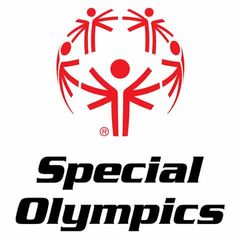By Abe Assaad; Monica Forquer, CPT, MS; Melissa Otterbein, MPH, CHES, Certified USA Triathlon Level II Coach
“My favorite trainers are the ones who work as hard to help me as I do to help myself every time I am at the gym. They know that for me, today matters.” -Abe Assaad, Special Olympics New Mexico Athlete, Health Messenger, and Special Olympics International Fitness Consultant
Abe Assaad is a Special Olympics athlete from New Mexico. He plays poly hockey, volleyball, track and field, softball, golf, swimming, basketball, flag football, and soccer. He has been involved in Special Olympics for 23 years. Abe practices 2-3 days per week for his sports and really loves staying active through his local Special Olympics teams. Abe also understands the value of staying active outside of his Special Olympics practices. He works with a certified personal trainer four days per week. With his trainer Adrian Baca, Abe completes flexibility, strength, conditioning, speed, and explosive exercises three times per week in the gym.
“My fitness and training goals are as important to me as any Olympic champion or professional athletes’ goals are to them. My trainer listens to my goals, takes them seriously and helps me achieve them," Abe reflects.
Abe is one of the approximately 200 million people with intellectual disabilities (ID) around the world. According to the American Association on Intellectual and Developmental Disabilities, ID refers to having a significant limitation in intellectual functioning and adaptive behavior starting before age 22. ID is the most common developmental disability, affecting 1-3% of the global population (Maulik et al., 2011; Patel et al., 2020). Common examples of ID include Down Syndrome as well as Autism.
Abe is also one of more than six million athletes and Unified Sports partners in over 190 countries and territories who participate in Special Olympics –a year-round global movement to end discrimination against people with intellectual disabilities that offers more than 30 Olympic-type sports and over 100,000 games and competitions every year.
Like Abe, many Special Olympics athletes enjoy going to the gym to workout. According to a 2021 survey conducted by Special Olympics and the IHRSA Foundation, people with ID who use gyms report doing so regularly and are highly motivated by improvements in their health and fitness. Among survey respondents who reported using the gym, 74% went at least twice per week, with 51.3% going two to three times and 22.7% four or more times. Weight loss, training for a sport or race, and having fun were among the top five reasons for attending a gym.
However, only one in 10 people with ID meet the guidelines of the World Health Organization for physical activity (Oviedo, G. R., Travier, N., & Guerra-Balic, M., 2017). People with ID are 2-4 times less likely to meet physical activity guidelines compared to the general population. This is a major factor for poorer health among those with ID. People with ID are two times more likely to be obese and have heart disease, five times more likely to have diabetes, and die 16 years earlier than their age-related peers (Heslop, P., et. Al., 2013; Segal, M. et. al, 2016; Krahn, G., & Fox, M., 2014).
People with ID are not less active because they are unmotivated. In fact, according to the 2021 Activity Alliance Annual Disability and Activity Survey, 81% of people with disabilities report wanting to be more active than they currently are. However, people with ID face several barriers when it comes to working out in the gym setting. In the IHRSA survey, we found that those who are not currently attending a gym were more likely to report a lack of self-efficacy and social support. Not having anyone to go with, or receive help from, especially around the use of equipment, being afraid of getting hurt, and the thought that they wouldn’t be good at exercising, were among the top barriers that people with ID listed in the survey. These are all solvable problems with the help of a trained fitness professional.
Unfortunately, 86% of fitness employees report that their current training does not adequately equip trainers and fitness professionals to work with people with ID (Raising the Bar, 2019).
In 2021, Special Olympics and ACE joined forces to mitigate training challenges by creating the free Special Olympics Inclusive Fitness Training. Fitness professionals can earn 0.1 continuing education credits by taking this 60-minute course to learn and understand the principles and strategies for effectively communicating, instructing, and motivating individuals with ID. It also prepares fitness professionals with basic adaptations needed for designing safe and effective exercise sessions for people with ID.
As noted by Special Olympics athlete Abe Assaad, “The best trainers are the ones who help me push myself as hard as I can. I love leaving the gym tired and feeling stronger and better about myself and feeling like I cannot wait to come back tomorrow.”
Stay tuned for our next blog post on how to build safe and effective exercise programs for people with ID. To see some of Special Olympic's free assesments and tools, click here. And don't forget to follow ACE on Instagram to learn specific fitness tests that you can use with people with ID.




 by
by 




 by
by